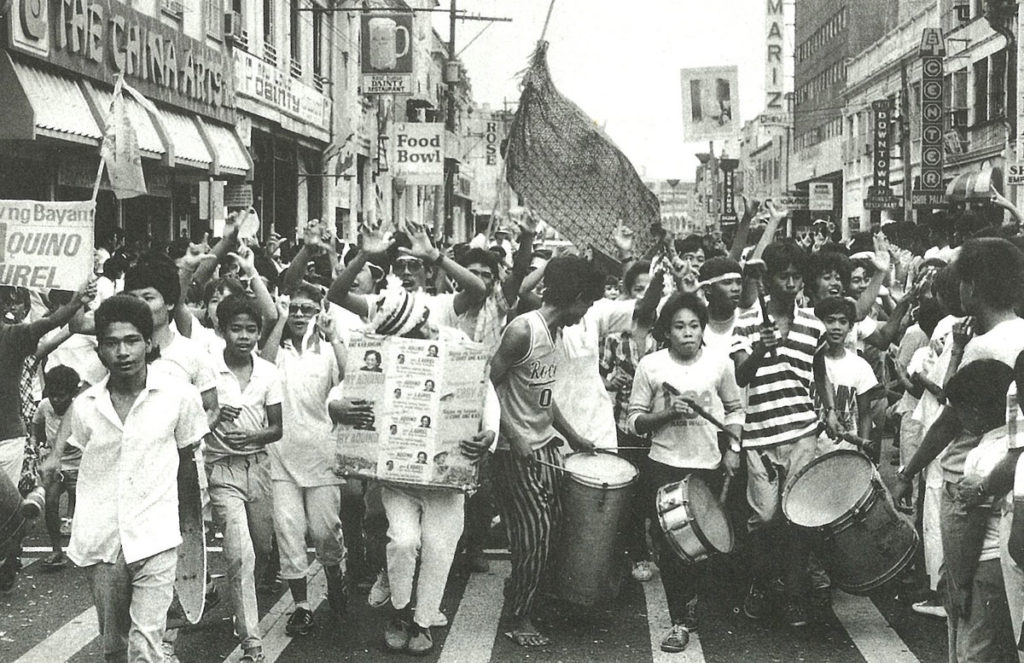Was EDSA a miracle?

People on the march during 1986 EDSA People Power uprising. OFFICIAL GAZETTE
Communist Party leader Hu Yaobang of China just wanted reform, giving a glimmer of hope to millions of his countrymen. He died of heart attack. Inspired by him, one million youth occupied Tiananmen Square 1989 to call for increased civil liberties and an end to state corruption.
Democracy-seeking and peace-loving people of China made a grave attempt to use people power versus the Chinese authoritarian government. Sadly, what they expected did not happen. The military took over as Deng Xiaoping’s governing Communist Party of China (CPC) declared Martial Law in the capital.
He was known as the Tank Man, an unidentified Chinese citizen who stood in front of a column of moving tanks at Tiananmen Square on June 5, 1989. It was a sad day when 200,000-strong People’s Liberation Army massacred their own, killing hundreds of unarmed civilians in a brutal crackdown on student pro-democracy protesters in Beijing. The massacre was among the bloodiest in modern political history sending shock waves across the world.
Three years back, in 1986, the EDSA Revolution was completely different. It was considered “indescribable and unexplainable,” making it one important turning point in the 500-year old Philippine history, when hundreds of thousands of Filipinos gathered together with roses and rosaries to topple a strongman. Those who were quite uncomfortable to use the word “miracle” too easily to describe what happened called it Divine Providence.
As expected, all these years the Marcosian trolls and the anti-yellow critics refused to accept the fact that the 1986 EDSA Revolution was a PPPP, “prayer-peace-and-people power.” However, history says that it is. Visit where it took place and see an EDSA Shrine built along the highway in honor of Our Lady of Queen of Peace at whose intercession the miracle of a great revolution happened.
The EDSA miracle has been compared to the Battles of La Naval de Manila, when Mary’s intercession repulsed the Protestant Dutch forces in their attempts to the invade the Philippines in 1646? The battles of La Naval de Manila were waged at sea, while EDSA was won in the highway. The battles of La Naval de Manila repulsed a non-Catholic aggression, while EDSA toppled an aggressive dictator.
At EDSA, the Virgin Mary’s intercession made a million praying people, with roses and rosaries, blocked advancing military forces. At La Naval de Manila, the inferior navy fired the shots against more superior forces, and the Catholics won. At EDSA, the advancing superior forces were ordered to fire but did not, and the Filipino people won. At EDSA, the miracle occurred when key officers of the Marcos dictatorship shifted their loyalties in favor of democracy. On the fourth day, the peaceful revolution was over.
The most significant fact remains, that, by people power, Filipinos achieved the impossible and brought down a seemingly unshakable strongman. From there, in a domino effect, the 1986 EDSA Revolution paved the way for the peaceful dismantling of the Berlin Wall and the return of democracies in South Korea, Romania, and others – except in China.
The reunified Germany acknowledged that the inspiration to bring down the Berlin Wall sprung from what the Filipinos did to regain democracy. In profound appreciation, the German government gave the Philippines a section of the wall, signifying the continuation of people power that began in EDSA that same year in 1986. A year later, huge demonstrations, locally tagged as “the Korean people power,” challenged South Korea’s strongman Chun Doo-hwa, a series of protests that eventually led to democratic reforms and the direct election of its president.
The EDSA Revolution inspired other pro-democracy uprisings in many corners of the world, rendering Prayer Power a special gift of the Filipino nation to the world. As the Latin word suggests, revolutio means “a turn around.” In other words, what happened at EDSA, from all dimensions of looking at it, was a fundamental and sudden change, “a turn around,” in socio-political control of power and government organization.
In military strategy, a revolution make use of the heaviest firearms, most effective maneuvering, and a lot of deadly weapons to achieve its goal. Therefore, a revolution is essentially a bloody process to achieve independence or reclaim democracy. Revolutionaries do not rely on prayers or flowers to exact a sudden change. If they do, that’s madness. Or perhaps a miracle.
“To those who believe, no explanation is necessary” goes a maxim attributed to St. Thomas Aquinas. “And to those who do not believe, no explanation is acceptable.”
Jose Mario Bautista Maximiano (jomaximiano@gmail.com) is the author of THE SIGNS OF THE TIMES AND THE SOCIAL DOCTRINE OF THE CHURCH: An Epistemology (Salesiana, 1991) and The Church Can Handle the Truth (Claretian, 2017).

